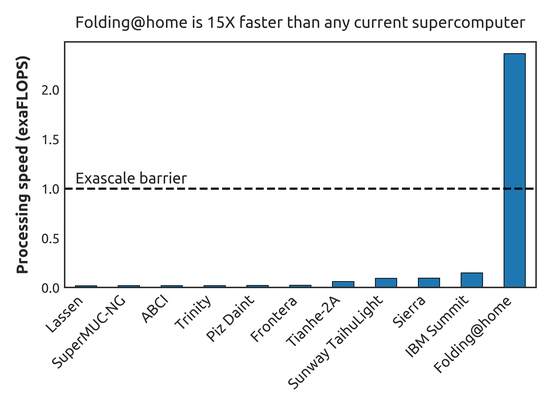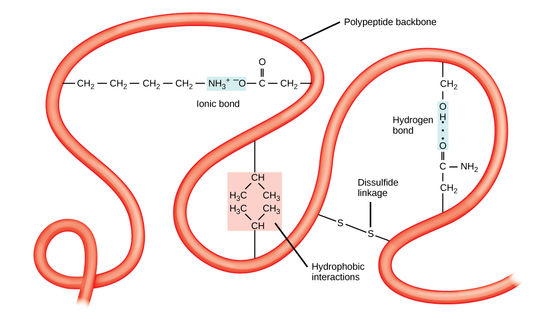The computing speed of 'Folding @ home', which advances the analysis of new coronaviruses using PCs all over the world, has reached the total performance of all the top 500 supercomputers in the world

'
With our collective power, we are now at ~ 2.4 exaFLOPS (faster than the top 500 supercomputers combined)! We complement supercomputers like IBM Summit, which runs short calculations using 1000s of GPUs at once, by spreading longer calculations around the world in smaller chunks ! pic.twitter.com/fdUaXOcdFJ
— Folding @ home (@foldingathome) April 13, 2020
The coronavirus pandemic turned Folding @ Home into an exaFLOP supercomputer | Ars Technica
https://arstechnica.com/science/2020/04/how-the-pandemic-revived-a-distributed-computing-project-and-made-history/
So What Is Protein Folding, Anyway? | Hackaday
https://hackaday.com/2020/04/14/so-what-is-protein-folding-anyway/
Below is a graph comparing the computing power of Folding @ home as of April 14, 2020 with other supercomputers, and the vertical axis shows the processing speed. Folding @ home is about to reach 2.4 exaFLOPS , which is 15 times faster than IBM Summit , which boasts the world's fastest processing speed, and this speed is faster than adding the computing power of the TOP500 supercomputer.

While IBM Summit processes by connecting many CPUs and GPUs, Folding @ home is a 'distributed computing' project that combines the processing power of household appliances around the world. The processing power of Folding @ home is proportional to the number of users who participate in the project, so 'popularity' is directly related to the processing power. Folding @ home started on October 1, 2000, but its processing capacity has been ups and downs for about 20 years since it started.
Sony's PlayStation 3 (PS3) game console brought the first peak in processing power of Folding @ home.
However, a turning point will come in February 2020. The total number of Folding @ home users jumped from 30,000 to 400,000 in March. In April it reached an additional 700,000. In modern times, the specifications of users' PCs have improved considerably, so at the moment the processing speed on the user side is too fast and the server side is overloaded.
This situation was created by the new coronavirus. Folding @ home has contributed 233 research papers , including important researches such as protein structure analysis of antibiotic resistant bacteria and Ebola virus. Of course, such Folding @ home will be used for analysis of the new coronavirus, and Nvidia officially tweeted, 'Let's use GPU computing power to fight COVID-19', so attention is gathered. It was.
PC Gamers, let's put those GPUs to work.
— NVIDIA GeForce (@NVIDIAGeForce) March 13, 2020
Us And Our Join Friends At AttoOfficialPCMR In Supporting Folding Atto Home And Donating Unused GPU Computing Power To Fight Against COVID-19!
Learn more → https://t.co/EQE4u7xTZT pic.twitter.com/uO0ZCq8PEv
Folding @ home is a project to analyze the three-dimensional structure called ' folding ' of proteins. Since hydrogen bonds and disulfide bonds are formed between the amino acids that make up proteins, each protein folds into a unique three-dimensional structure and is stabilized. Since this unique three-dimensional structure is difficult to predict from the sequence of amino acids that make up proteins, it requires super-high-speed computing capabilities such as Folding @ home.

Several projects are underway to analyze the new coronavirus using the computing power of Folding @ home. On April 13, 2020, a study on the replication-competent protein ' RNA-dependent RNA polymerase (RdRp) ' within the novel coronavirus was announced . Most of the vaccines currently under development target the surface antigen of the new coronavirus, but this surface antigen is also likely to evolve to have drug resistance by mutation. It is pointed out that the developed vaccine will become useless. ' However, according to the research team, although RdRp is difficult to study because it is located inside the virus, it is very difficult to mutate, so it is a promising drug target.
You can use your own PC to contribute to Folding @ home, which is also researching the new coronavirus. The following article explains how to actually participate in Folding @ home and cooperate with the analysis of the new coronavirus.
`` Folding @ home '' `` BOINC '' review that can help you analyze new coronavirus using your PC's computing resources-GIGAZINE

Related Posts:
in Software, Web Service, Science, Posted by darkhorse_log






